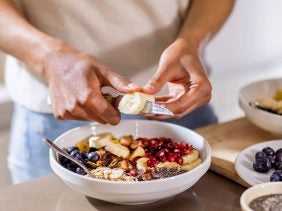Cycle Syncing – how to synchronize your cycle and lifestyle
 ©Igor Ustynskyy
©Igor Ustynskyy
For far too long, menstruation and menstrual cycles have been somewhat taboo to discuss, which unfortunately often means they carry negative associations. Cramps and bloating, bad moods, fatigue – people are told they just have to grin and bear it, that chocolate will take care of it. It’s about time we put an end to that. Your cycle is not only something very natural, but understanding it is a powerful tool you can make great use of instead of just letting it happen to you. Cycle syncing was coined by hormone and nutrition expert Alisa Vitti in her book Woman Code, and the practice is continuing to rise in popularity – and with good reason. Cycle syncing promotes aligning your daily life and all the challenges it brings with your hormonal cycle, thereby finding more energy, productivity, and serenity. In addition, you can gain control over symptoms that you may think of as inevitable, be it severe inflammation and cramps, blemished skin, or uncontrollable cravings. You are in control and can have more influence on yourself and your body than you think.
How does cycle syncing work?
If you menstruate, it’s helpful to know your hormonal cycle and its phases and to keep track of which one you’re in. This not only gives you a better understanding of what’s happening in and with your body and hormones, but you can also use these phases for an improved mind-body connection and a more carefree everyday life.
Your hormone balance changes every cycle phase, or even daily. Once you’ve observed for a while how you feel in which phase, you’ll be able to recognize recurring patterns, and you can adapt your everyday life to them. For example, you can try to avoid having an important meeting at a time when you often feel less energetic. Of course, we know this isn’t always possible. Still, it may be worth the effort to try. Keep in mind that your body and its hormone levels change from day to day, so you don’t have to perform the same way every day either. Cut yourself some slack. By adjusting your diet, exercise, and daily tasks to your cycle and energy level, you can get the most out of yourself.
The four phases of the cycle
The average menstrual cycle (without the influence of hormonal contraceptive methods) lasts about 25-35 days and can be divided into four phases. Please remember that everyone and therefore their cycle is individual and might vary from these average values.
Follicular phase
Your hormones: The follicular phase lasts about 7-10 days. Levels of the hormone FSH (follicle stimulating hormone) increase to enable follicular growth in the ovaries, in which the egg is located. The hormone estrogen is at its lowest level and slowly begins to increase.
Your lifestyle: Your energy and creativity are picking up steam. This phase is great for finally tackling projects you may have been putting off, socializing, being out and about, and being active. Be sure to eat foods that best support your energy levels and dare to try new things, including new kinds of movement or a new sport. Now is exactly the right time. Our Energy Aminos support you additionally before your next workout!
Ovulation phase
Your hormones: Ovulation lasts about 3-4 days. FSH rises again, as does LH (luteinizing hormone) and estrogen, which then falls again to induce ovulation. These days are the fertile ones. For some, ovulation is accompanied by headaches, cravings, or other symptoms that may result from the initial rise in estrogen.
Your lifestyle: In this phase, your communication skills can be particularly good, so it’s worth having important conversations right now, if possible. As far as exercise is concerned, you can go full throttle. It can be even more motivating to work out with a training buddy. We’ll show you how to find the perfect gym buddy.
Luteal phase
Your hormones: In this phase, which can last 10-14 days, a corpus luteum is formed from the former follicle, which produces progesterone. Estrogen levels increase again. You may notice that your energy level decreases, and some people may even experience PMS, premenstrual syndrome, during this phase. This can manifest in headaches, cravings, mood swings, and other symptoms.
Your lifestyle: It’s important to listen to your body and not force yourself to do anything. It’s okay to replace your workout with a yoga session or a walk, especially at the end of this phase, and to stay home in the evening instead of going out. If you can, don’t schedule stressful meetings and the like. Use this phase for yourself, for example, to try out new recipes or finally read the book that has been waiting for you for so long. Your diet can help you reduce PMS symptoms. Whole grains can help your body break down estrogen. Also, make sure you’re getting enough nutrients and support your zinc and magnesium balance with our Zn:Mg capsules.
Menstruation
Your hormones: If pregnancy doesn’t occur, the corpus luteum regresses, thus no longer producing progesterone, and menstruation begins. Menstruation often lasts 3-7 days.
Your lifestyle: Your right- and left-brain hemispheres now communicate particularly well with each other, which may allow you to perceive your intuition even better. Vitti recommends that you make use of this by, for example, writing in a diary, reflecting, and setting yourself new goals. What went well last month, what went poorly, and what might you want to change? Allow yourself to eat things that comfort you, but still make sure to eat healthy and nutritious foods. A warm, healthy soup can be especially beneficial right now.
Since menstruation is stressful for your body, the first 1-3 days are not the best time for intense workouts. Give your body time. But again, as always, you know best what’s good for you. Just be careful not to stress yourself out and overexert yourself.
Want to learn more about training on your period? These are the facts you should know.
What are the advantages of cycle syncing?
Admittedly, restructuring your entire daily routine is no easy task and doesn’t happen overnight. Wonder if it’s really worth it and worth the effort? Our answer: a resounding YES!
Reaching your goals more easily
Asking for that well-deserved raise, going on a date, giving a presentation, or finally setting a new personal record during a workout – there are many challenging everyday situations in which you want to be the best version of yourself. It’s not always easy, but everything you need in order to do that is already inside you: self-confidence, energy, and motivation. You just need to tap into it. We also have 10 more tips to help you achieve your goals.
Becoming more intuitive
Often, we’re so distracted by our everyday life that we don’t listen to what our body wants to tell us, or what we actually want and need. Your mind-body connection will improve significantly through cycle syncing. You’ll know when you have the most energy to work out and when it’s time to take it easy.
Improving your mood
Because your everyday life has to adapt to you and not the other way around, you’ll notice how your mood improves in the long run, and you’ll go through life more relaxed and in a bigger mood.
Reducing PMS symptoms
With a more stress-free daily routine and a balanced diet, cramps, blemished skin, and cravings can be a thing of the past.
Improving your relationships
Whether at work or in your personal life, by knowing when you need time for yourself and when you are open to good conversation, relationships with those around you will improve.
Valuing yourself more
The most important relationship is the one with yourself. Be mindful of yourself and your body and listen to your needs. You can find tips for more self-love here.
And if sometimes nothing helps, the tried and true remedy is and remains: chocolate! With our protein brownies you save a lot of sugar and can still satisfy your cravings optimally!
More things to know from foodspring:
- How menopause affects your body fat and fitness
- Intuitive Eating: What It Is and How You Can Do It
- Strength Training for Women: The key to get your body feeling its best!
- 10 New Ways to Think About Sugar
- Heat things up with these 5 natural aphrodisiac foods
Sources for this article
We at foodspring use only high-quality sources, including peer-reviewed studies, to support the facts within our articles. Read our editorial policy to learn more about how we fact-check and keep our content accurate, reliable, and trustworthy.
- Vitti, A. (2014). Woman Code (1.Auflage). Harper One.





























